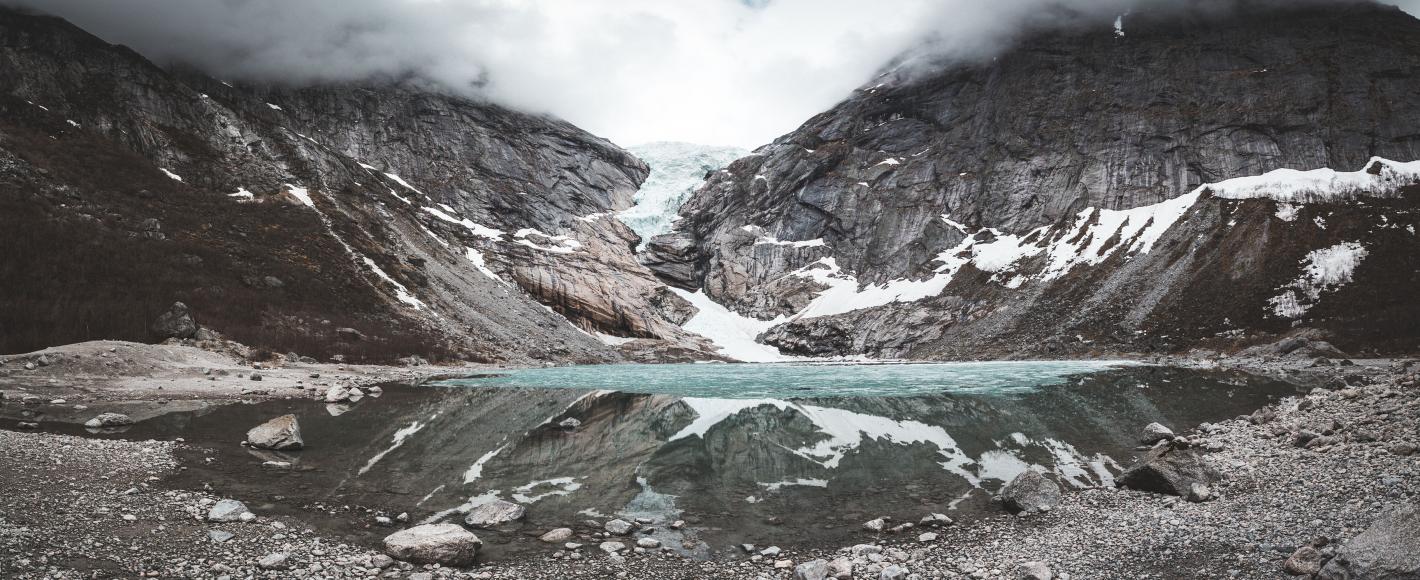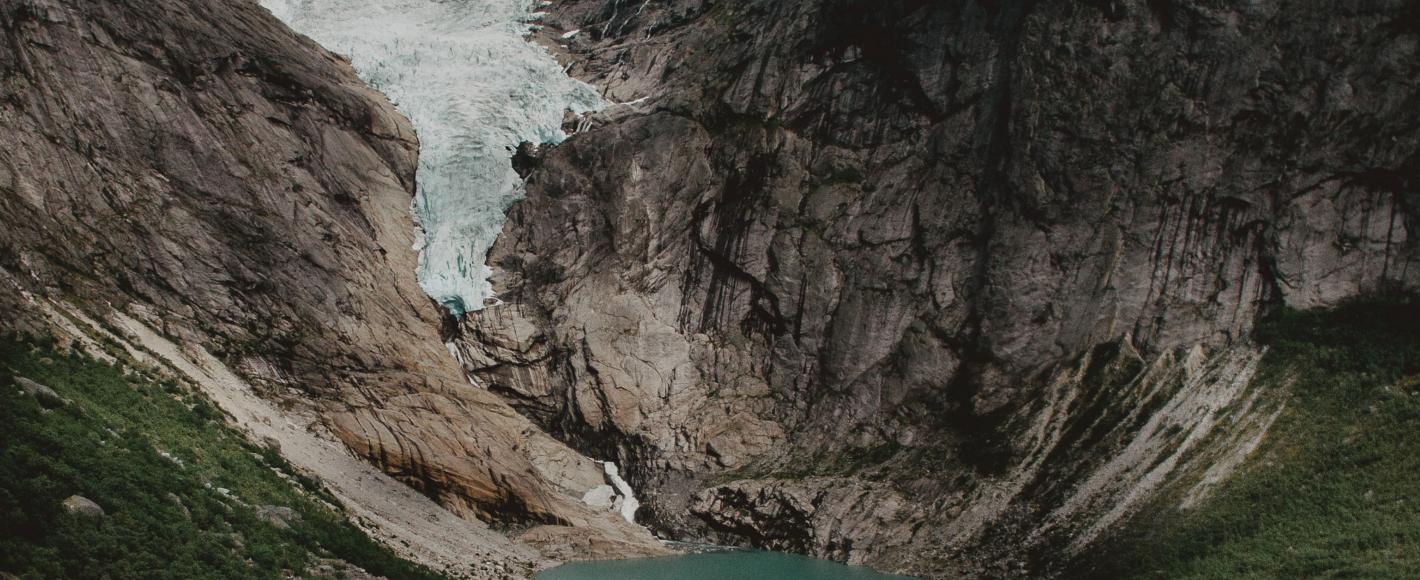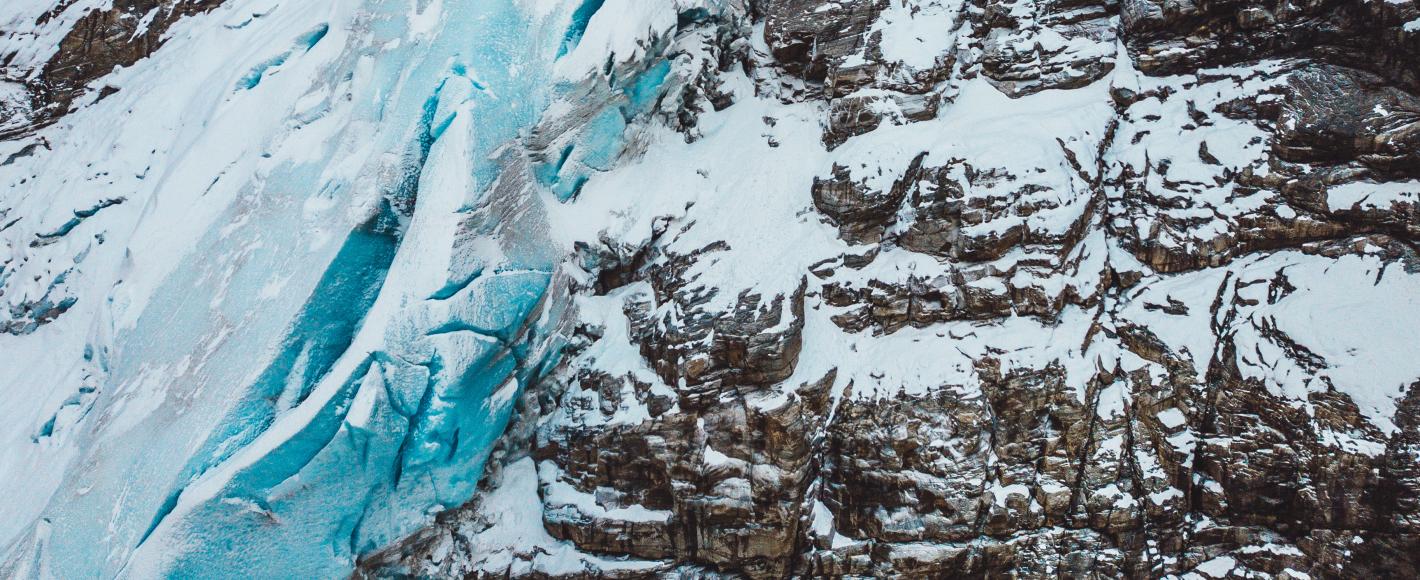The glaciers sparkle between narrow valleys in Nordfjord. At 487 square kilometres, Jostedalsbreen is the largest glacier in mainland Europe.
The ice has formed the landscape over the course of three million years. When it retreated, the spectacular landscape of Nordfjord unfolded between the ocean in the west and the massive glacier on the roof of Norway.
The contrasts are perhaps the most fascinating aspect of the Jostedalsbreen glacier, from lush small communities to bright blue fjords and snow-covered mountain peaks of more than 2,000 metres up on the glacier plateau. The highest mountain near the glacier is Lodalskåpa (2,083 metres).
The Jostedalsbreen glacier is a temperate glacier, which means that water runs under the glacier and it is at pressure melting point. Since i
t is temperate, it erodes the terrain on which it sits and can therefore move.
Experiencing this magical, blue landscape of ice is an experience that is a must on any trip to Norway. This is nature at its most beautiful and most spectacular. A glacier is a fascinating natural phenomenon, and the earth’s climate gauge.
The glaciers are natural laboratories, particularly with respect to climate change, geology and vegetation/flora. The movement of the glaciers contributes to constant changes in the landscape. The glaciers probably melted away during a period when the climate was warmer 5,000 to 8,000 years ago. When the climate again started to cool down, the Jostedalsbreen glacier and other glaciers started reforming. Near the glacier, there is an interesting cultural landscape that is still used for agriculture and as grazing land. There are around 1,600 glaciers in Norway, which cover an overall area of around 2,700 square kilometres. About 600,000 people visit Jostedalsbreen National Park every year.
The glaciers along the coast of Fjord Norway increased in size during the 1990s, but this trend has currently been reversed due to little snow and warm summers. Since the early 2000s, most of the glaciers in Norway have receded, mainly as a result of warm summers. Not all of Norway’s glaciers are accessible to tourists, but there are many routes across the Jostedalsbreen glacier, and our three national park centres around the glacier, among others, can organise or help you arrange glacier walks. The local Tourist Information offices will also be happy to provide information.
You can see spectacular glacier arms of the Jostedalsbreen glacier in Nordfjord. The best known and most visited among them is the Briksdalsbreen glacier. The Brenndalsbreen glacier is located in the neighbouring valley, and the Kjenndalsbreen and Bødalsbreen glaciers are at the head of Lodalen valley.
Traces of the Ice Age
Deep cracks in the glaciers, avalanches and the unpredictability of the moving ice mean that you should never venture out onto a glacier alone. It is important to respect the barriers that have been erected. However, professional guides and the right equipment make a glacier walk an experience that will appeal to the adventurous.
Even at a depth of a hundred metres, the glacier is in constant movement and is strong enough to literally shape the earth. Ice-Age glaciers carved out and formed Norway's characteristic fjords, valleys and mountainsides.
Jostedalsbreen National Park
Jostedalsbreen National Park, which was founded in 1991, covers an area of 1,310 square kilometres. The Jostedalsbreen glacier is the biggest glacier in mainland Europe, and covers 487 square kilometres of the park.
There are also many other large and small glaciers in the national park. Seven municipalities have areas within the national park, and the Jostedalsbreen glacier sits between two of the world's longest fjords, the Sognefjord and the Nordfjord. In 2008, Stryn was awarded National Park municipality status. The landscape of Jostedalsbreen National Park ranges from lush valleys to alpine mountains and an arctic climate. The heart of the National Park comprises an untouched landscape that can only be reached on foot. You can learn more about the landscape around the glaciers at Jostedalsbreen National Park Centre.
One of the most unique features of the Jostedalsbreen glacier in olden times was the kinship and sense of community between the small communities on either side of the glacier. The old highways and byways crossed the glacier.
The birth of tourism
The first tourists made their way to Briksdalen in the mid-1800s, and were generally English upper class. However, the opening of the Rustøen–Briksdal road in 1890 heralded a new era for tourism. Many of the tourists were driven to the glacier in hay carts that were subsequently replaced by simple passenger carts. Tourism really took off after World War I. One to two thousand tourists could visit the Briksdalsbreen glacier in a single day. A return ticket on Oldenvatnet lake on the ‘Briksdal’ boat cost 30 øre. There was no road to Oldedalen until 1955, which meant that its inhabitants depended on the lake as a means of transport. The first motor boat was put into operation in 1915, and it serviced the fjord every day throughout the year. In 1891–1892, Anders Briksdal built a tourist cabin and sold, among other things, beer, fizzy drinks, milk, bread and rømmekolle (a traditional sour cream dish). People who were going to cross the glacier to Jostedalen or walk to Jølster through Oldeskaret ravine could spend the night there. Tourism stopped during the war. After the war, the Briksdal family engaged in tourism and farming, but tourism took more and more over and they sold their goats i 1966. The barn on the farm was converted into a souvenir shop and accommodation for tourists. In 2005, horse-drawn carriages were replaced by ‘troll cars’, which have more capacity.
The glaciers are retreating
Global warming has led the temperature to rise in Norway, as in the rest of the world, with the result that the glaciers are slowly melting and retreating. The total area covered by glaciers has been reduced by 11 per cent over the past 30 years according to the Center for International Climate Research (CICERO), and more than 326 square kilometres have disappeared since the mid-1980s. The glaciers in the northern areas of Norway have been particularly affected.
RELEVANT PRODUCTS




